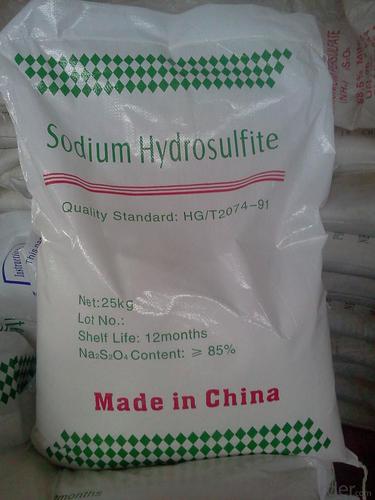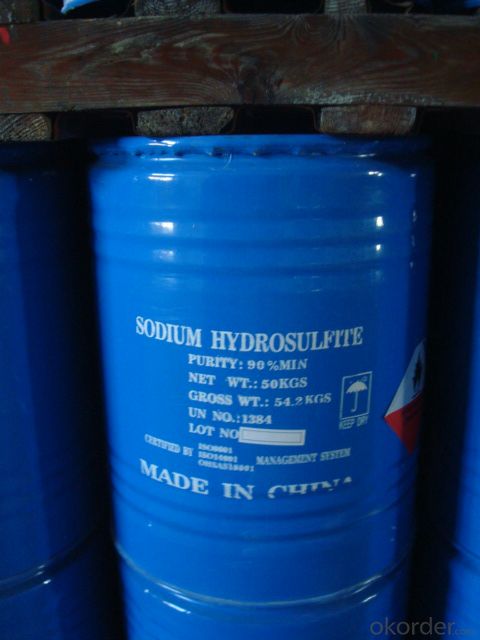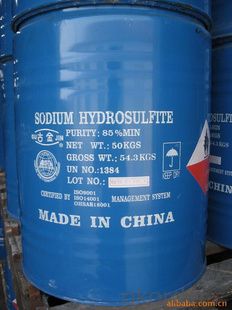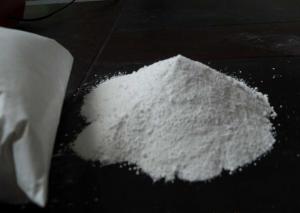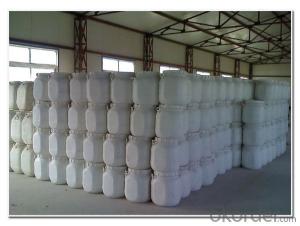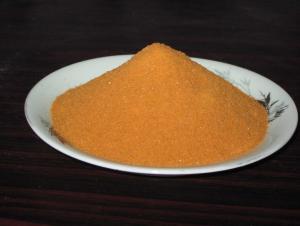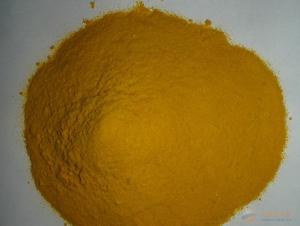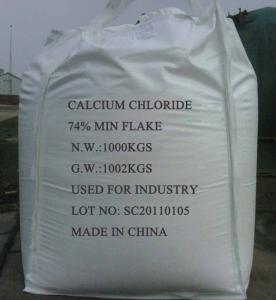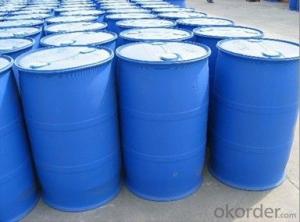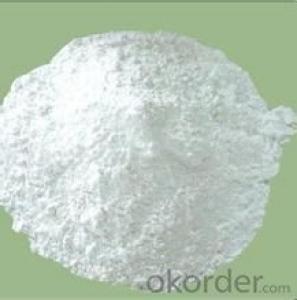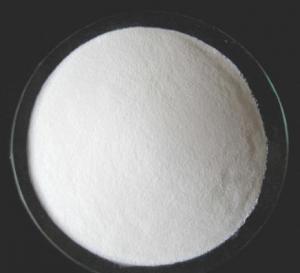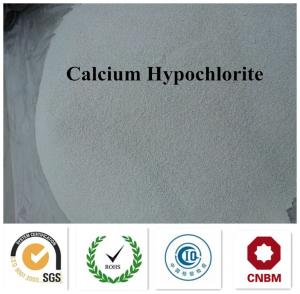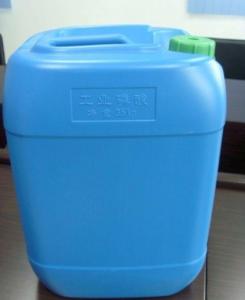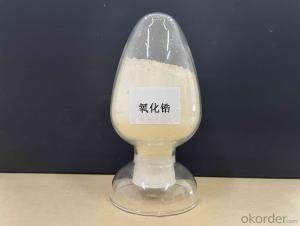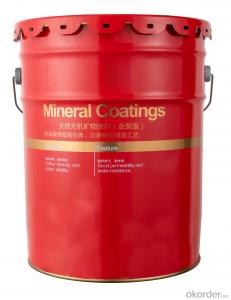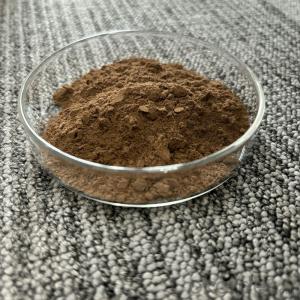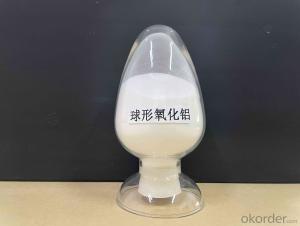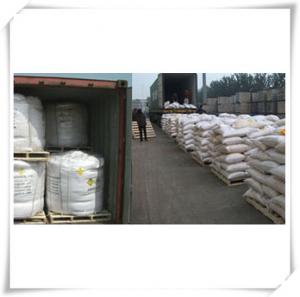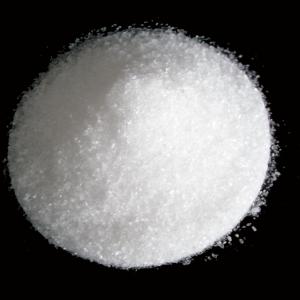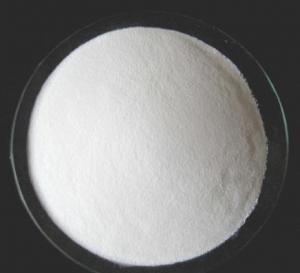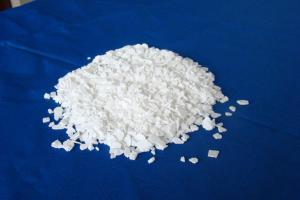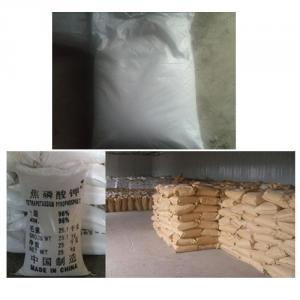Sodium Hydrosulphite with High Quality and Good Offer
- Loading Port:
- Qingdao
- Payment Terms:
- TT or LC
- Min Order Qty:
- 22 m.t.
- Supply Capability:
- 3000 m.t./month
OKorder Service Pledge
OKorder Financial Service
You Might Also Like
1.Structure of Sodium Hydrosulfite Description:
Commodity name: Sodium Hydrosulfite Na2S2O4 Sodium Hydrosulfite Sodium Dithionite Price
Molecular formula:Na2S2O4
Molecular weight:174
CAS Number 7775-14-6
H.S code 28311010
UN number 1384
Class 4.2
2.Main Features of Sodium Hydrosulfite:
It is a versatile chemical that's used in the manufacture of a variety of products we all use every day,
from photographic film to wine; from fine writing papers to leather goods; from colored fabrics to metal recovery.
While the applications for this chemical workhorse are as vast and as varied as the industries that use it,
in most cases, sodium hydrosulfite performs one of the following three roles:
1) As reducing agent, hydrosulfite chemically reduces othercomponents by donating an electron or electrons
2) As sulfonating agent, hydrosulfite adds sulfur to another chemical compound
3) As cation source, hydrosulfite adds a cation, or sodium, to a product system
3.Sodium Hydrosulfite Images
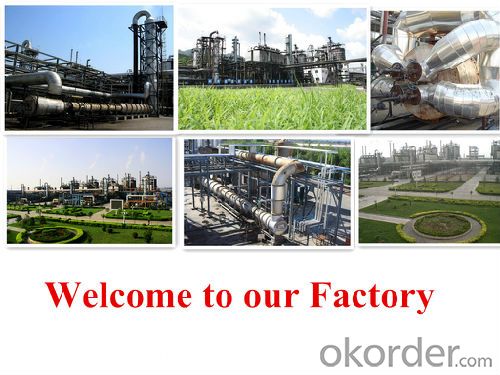

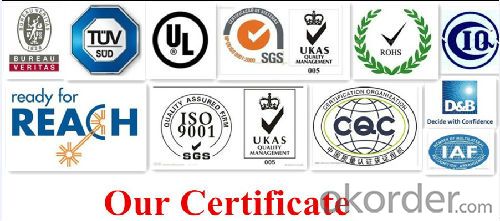
4.Sodium Hydrosulfite Specification
Standard:HG2932-1999
Index | Technical Grade HG/T 2074-2011 | Food Additive GB 22215-2008 | ||
Na2S2O4, | ≥ 90% | ≥ 88% | ≥ 85% | ≥ 88% |
Iron (Fe), | ≤20ppm | ≤ 20ppm | ≤ 20ppm | ≤ 20ppm |
Zinc (Zn), | ≤ 1ppm | ≤ 1ppm | ≤ 1ppm | ≤ 1ppm |
solution appearance | clear | clear | clear | clear |
EDTA, | / | / | / | qualified |
Arsenic(As), | / | / | / | ≤ 1ppm |
Other heavy metal( As Pb), | ≤ 1ppm | ≤ 1ppm | ≤ 1ppm | ≤ 1ppm |
Formate (As HCHO), | / | / | / | ≤ 0.05% |
water insolubles, | ≤ 0.05% | ≤ 0.05% | ≤ 0.05% | / |
Cadmium (Cd) | / | / | / | ≤ 2ppm |
Plumbum (Pb) | / | / | / | ≤ 5ppm |
5.FAQ
1, are you a trade company or factory?
We are a trade company.
2, what is your main product?
My main product is ammonium chloride all grade. We have special advantage in FEED
GRADE.
3, how do you control the quality?
We do quolity control by the factory testing department. We also can do FDA,BV, SGS or any orther Third-party testing.
4, how about your packing?
My main packing is 25kg or 1000kg PP PE or kraft bag , with or withour pallets,with or without anticaking. We also can make packing and shipping mark are your ask, such as 50kg/50bl bag.
5, how long time you can make the shipping?
We can make the shipping within 5-10day after confirm the order.
6, why you buy from me?
We have stable quolity and price, not best quolity and price. It is not true for best quolity and best price. Our factory is manufacture according the BP USP and FCCIV terms. We have in this line for more than 8 years. We are one of the biggest exporter from Qingdao port.
- Q:How much of the body's inorganic salts account for the weight of the body?
- The inorganic salts in the human body account for about 5%
- Q:Several kinds of inorganic salt food sources?
- Phosphorus-rich foods: fish, lean meat, untreated cereals, eggs, dried fruits, all kinds of seeds, etc. Almost all natural foods
- Q:in the ocean
- Salts are the result of the association of cations and anions. Cations are usually metals like Calcium, Sodium, Potassium anions are ususally sulfates, phosphates, carbonates...... calcium carbonate and calcium phosphate are useful in making bone. Potassium Chloride is important in heart beat regulation Sodium Chloride is important in maintaining blood pressure. Carbonate is important in blood chemistry and the transfer of energy within a cell. all these salts are found in abundance in the ocean. If you follow evolution, those salts in the ocean have given rise to our own blood chemistry and organic health.
- Q:What do we get from the milk?
- Milk is rich in minerals, calcium, phosphorus, iron, zinc, copper, manganese, molybdenum. The most rare is that milk is the best source of calcium in the human body, and the proportion of calcium and phosphorus is very appropriate, conducive to the absorption of calcium. Species is complex, at least 100 kinds, the main ingredients are water, fat, phospholipids, protein, lactose, inorganic salts
- Q:What fruit contains more minerals?
- Watermelon fruit contains 90% or so, so there are "watermelon," said watermelon contains a variety of nutrients and chemical substances. Watermelon pulp contains protein, sugar, crude fiber, potassium, phosphorus, calcium, iron, sodium, magnesium Chlorine, niacin, vitamin A, vitamin B1 and vitamin B2 in the watermelon juice also contains citrulline, alanine and glutamic acid and other amino acids, malic acid and other organic acids, pectin and a small amount of glycosides, and Medlar, cinnamon and other alkaloids and so on.
- Q:What foods contain inorganic salts?
- Most of the food contains inorganic salts, the so-called inorganic salts, also known as minerals or ash. Minerals are naturally occurring compounds or natural elements in the crust. There are about 50 kinds of minerals in the human body, although they in the human body only 4% of body weight, but it is an essential part of the organism. Kelp, jellyfish, seaweed, moss; bones, soy products, lean meat, animal liver, brown rice and so on.
- Q:What to eat can promote the absorption of inorganic salts
- Transpiration on the absorption of inorganic salts has little effect, the book or which exercises on the image shows the problem
- Q:During the different periods of plant growth, the amount of water and inorganic salt required is different.
- Plant life, although the need for a variety of inorganic salts, but different plants on the various types of inorganic salt requirements are different, such as cabbage, spinach and other human needs leaves of vegetables need nitrogen containing inorganic salts, tomato, peanuts need phosphorus Of the inorganic salt and more, sweet potatoes, potatoes need potassium-containing inorganic salts; the same plant with the growth period of the different requirements of inorganic salts are not the same, for example, plants in the seedling period requires nitrogenous inorganic salts , In the flowering, the results of the period of time need more phosphorus-containing inorganic salts. Therefore, different plants and the same plant growth period, the need for inorganic salts are different. So the answer is: different; different
- Q:Is iodized salt inorganic or organic?
- A salt would be organic if it contains carbon atom in it. So NaI (Sodium Iodide) is inorganic but CH3I (Methyl Iodide) is organic.
- Q:What is the inorganic salt
- The main sources of various inorganic salts and the lack of the main performance (1) sodium sodium is the main ingredient of salt.China's nutrition society recommended adults over 18 years of age sodium intake of 2.2 grams per day, the elderly should take light food Sodium is commonly found in a variety of foods. The main sources of sodium are sodium, soy sauce, pickled foods, smoked foods, salty foods, etc. (2 Calcium is an important part of bone. Disease, osteoporosis, etc .. China Nutrition Society recommended adults aged 18-50 adult calcium intake of 800 mg per day; 50 years of age in the elderly 1000 mg.General calcium-rich foods are milk, yogurt, Oatmeal, sea cucumber, shrimp, wheat, soybean meal, soy products, lily, etc. (3) magnesium is the necessary elements to maintain the structure and function of bone cells.Magnesium deficiency can lead to nervous tension, emotional instability, muscle tremor and so on. (4) Phosphorus is an important part of the composition of bones and teeth. (4) Phosphorus is an important component of bone and teeth. (4) Phosphorus is an important component of bone and teeth. Severe phosphorus deficiency can lead to anorexia, anemia, etc. China Nutrition Society recommended adults over 18 years of age the appropriate intake of phosphorus is 700 mg. Common phosphorus-containing foods are lean meat, eggs, milk, animal offal, kelp, Nuts, coarse grains. (5) Iron is the most content of trace elements in the human body, iron and the human body's life and its health are closely related to iron deficiency will lead to iron deficiency anemia, immunity decreased. China Nutrition Society recommended 50 years old More than men's or women's iron daily intake of 715 mg. Common iron-rich foods are animal liver, kidney, caviar, lean meat, potatoes, wheat bran.
1. Manufacturer Overview |
|
|---|---|
| Location | |
| Year Established | |
| Annual Output Value | |
| Main Markets | |
| Company Certifications | |
2. Manufacturer Certificates |
|
|---|---|
| a) Certification Name | |
| Range | |
| Reference | |
| Validity Period | |
3. Manufacturer Capability |
|
|---|---|
| a)Trade Capacity | |
| Nearest Port | |
| Export Percentage | |
| No.of Employees in Trade Department | |
| Language Spoken: | |
| b)Factory Information | |
| Factory Size: | |
| No. of Production Lines | |
| Contract Manufacturing | |
| Product Price Range | |
Send your message to us
Sodium Hydrosulphite with High Quality and Good Offer
- Loading Port:
- Qingdao
- Payment Terms:
- TT or LC
- Min Order Qty:
- 22 m.t.
- Supply Capability:
- 3000 m.t./month
OKorder Service Pledge
OKorder Financial Service
Similar products
New products
Hot products
Hot Searches



